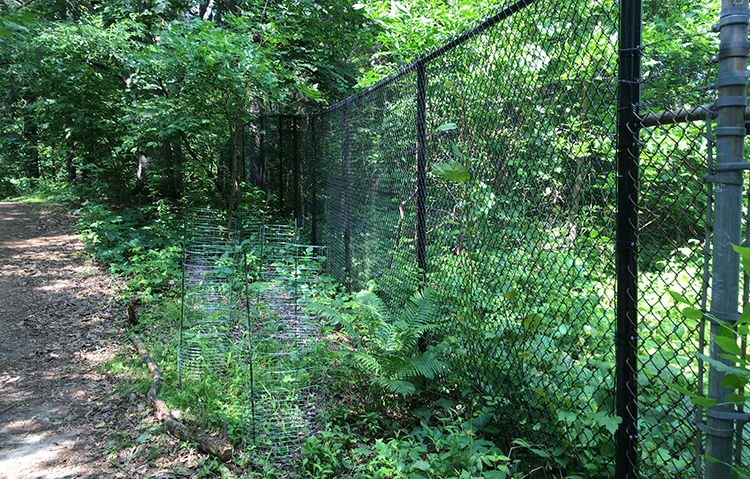
The Friends of the Wildflower Garden
Upland Additions to Eloise Butler Wildflower Garden
1944

When the original dimensions of Eloise Butler Wildflower Garden were determined in 1907 the area was contained within Glenwood Park (now named Theodore Wirth Park). Eloise Butler and her fellow botany teachers concentrated their efforts on a section containing a rare tamarack swamp. Within a few years adjacent hillsides and an open meadow to the North were added, enlarging the Garden's space to between 20 and 25 acres. It was not until the 1940s when Martha Crone was Curator that the idea was first generated of adding an upland oak savanna environment to the Garden.

Clinton Odell, President of the Burma-Vita Company, and future founder of The Friends of the Wild Flower Garden, had offices on Chestnut Street just blocks from the Garden. He had been a botany student of Eloise Butler and he frequently spent time in the Garden helping Martha Crone with weeding and planting. In June 1944, Odell wrote to Minneapolis Board of Park Commissioners (Park Board) Superintendent C. A. Bossen, proposing to donate $3,000 to cover the cost of clearing an upland garden, fencing in the new area, tarvia surfacing the paths both in the lower Garden and the newer portion, positioning settees on the center hill of the new upland and constructing a small summer house near the Garden Office.(1)

At some point during the Summer of 1944 the Park Board felt certain of Odell's requests should be “wait and see” as Mrs. Crone developed the area, in particular the paving of paths and construction of facilities. The paths were left to Martha Crone to complete and there was no surfacing except what Martha could accomplish. Many paths of Wirth Park already traversed that new section and she used many of them.
On August 29, 1944 Clinton Odell wrote to the Board of Park Commissioners in reply to their comments.(2) He noted that he had met with various Park Board staff and those meetings had “resulted in our practical agreement on the various features of the program as outlined in my letter of June 29, 1944 to the board.” He added "My thought has always been that the moving of the fence to enclose the upland garden, tarring the paths and other construction features should wait until at least the end of the war in Europe, at which time they should fit nicely into a post war work program."
He noted his donation of a wood stove and stove pipe for the office and that a Park Board truck had picked it up at his home and it was being installed. He referenced that the Park Board architect was working on the design for the upland and for the construction; he requested that Mr. Bossen allow Martha Crone some time off to gather new plant material for the upland; and then outlined his financial commitment and how and what records he wanted to keep track of it. [In 1944 the amount he was donating was a substantial amount of money. In terms of purchasing power after inflation the $3,000 of 1944 is equivalent to $44,000 in 2020.] At this point the Park Board had not yet given its approval to the entire project as he concluded "I shall await with interest your final action on my proposal as approved by your committee and particularly in the meanwhile I am happy to have Mr. Wirth's enthusiastic approval." [Wirth had retired as Superintendent at the end of 1935, but was obviously still being appraised of events and in fact, was one of people Odell referenced meeting in his letter of August 29.]
Odell sent an initial check for $1,500 and in subsequent years between 1944 and 1952 (until The Friends were founded) he reimbursed the Park Board for what they spent, eventually exceeding his original $3,000 offer by $4,000 additional. Most of these annual donations were reported in the Star Tribune. [PDF format examples of newspaper notices.]
Below: Before and after aerial views of the upland area. Note the large number of trees removed in the 1947 photo.
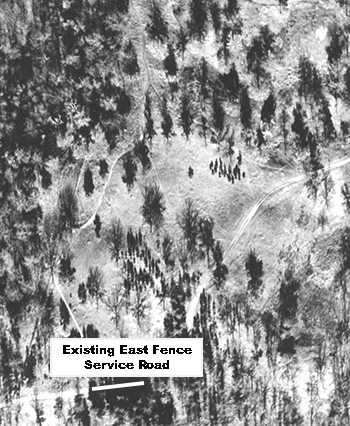
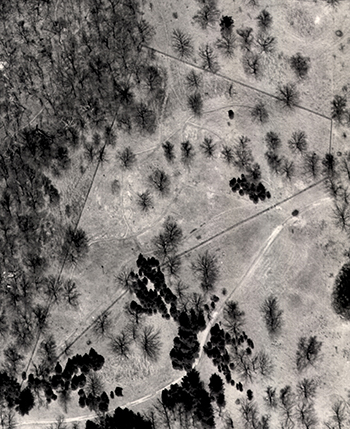

In 1944 the Board spent $1,009 on this project; in 1945 the amount was $1,116 and he sent another $1,500. In 1946 the amount for that year totaled $1,314. Each year the Park Board sent a summary to Odell and he paid any amount due above his $3,000 deposits. In addition to this in 1945 he paid for the wages of a second man to help Martha Crone, a Mr. John Schulte. In 1946 he did likewise but had to dismiss Schulte early for the reason stated as “they did not agree” and he was looking for a replacement. In 1947 he simply sent the Park Board $1,000 for the purpose of paying for help and in the subsequent years of 1948, through 1951 he sent $500. (3) With the development of the upland area now, for the first time, Martha Crone had some help in the Garden.
Martha Crone wrote in her 1945 report to the Park Board that the addition added about 10 acres. Based on what is known about the size of the current woodland garden and wetland area which was fenced in 1938, her acreage number is much too high. [The large north meadow which was part of Eloise Butler's 20 to 25 acre garden had been abandoned by this time.] As the total Garden area prior to the most recent expansion in 1993 was 14 acres, then the upland area was no more than 4 to 5 acres. Gardener Cary George wrote in 1994 that the one acre 1993 upland addition added 20% to the size of Upland Garden. (The Fringed Gentian™ Vol.42 No 1).
Abandonment of the Mallard Pool
This acreage count given above for the Garden would have then excluded the north meadow where the Mallard Pool had been constructed in 1932. Martha had made no notes in her log about doing anything in the Mallard Pool area after 1939 except for notes in 1946 and 1947 about removing some plants from that area and transferring them to the current Garden space. We believe the Mallard Pool area was completely abandoned in 1944 for reasons stated in the next paragraph. The fence outline of the woodland and wetland shown on the 1987 map above is the same outline of the Garden at the time of the 1944 proposal and also agrees with Martha's 1952 map (see 1952). Full history of the Mallard Pool is in this article.
Martha Hellander's research found correspondence between Clinton Odell and the Park Board containing his original idea on adding the upland to the existing garden. He advocated abandoning the northern area because it was swampy and also that it should never have been fenced in. (The Wild Gardener, Pg. 104) [Swampy after several very wet years in the early 1940s, but also because it was already a cattail marsh at the time Eloise Butler created the Mallard Pool there in 1932.] Former Gardener Cary George has stated to me that the fence from the northern meadow was removed and used to fence in the new area. It was wartime and steel fencing could not be easily obtained. (Conversation on May 18, 2018). Other notes of Martha Crone in 1939 (diary) indicate some of the fencing in the northern area was installed that year - other parts of it could date to Eloise Butler’s 1924 fence. Historical Garden Fencing Details.
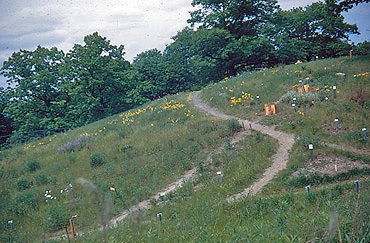
In the Autumn months Martha and Park Board maintenance workers began clearing sumac and other unwanted plants from the Upland area. In his August 29 letter referenced above, Clinton Odell had noted that "The preparation of the upland garden tract should include the removal of several black oaks of little value and considerable sumac." Then on about November 9 and again on November 16 he met with Superintendent Bossen at the Garden and apparently made several more requests for plant removal including more oaks. The superintendent writes in reply on Nov. 17 and recounts how Mrs. Crone had met several weeks earlier with the maintenance people and supervisors and they had designated what trees and shrubbery should be removed, and that the work crews were now busy with that work.
The superintendent then says 'wait a minute.' Operations were just starting, there was sufficient open space, we should wait until developments tell us what to do. "The oak trees have taken a great many years to grow and they should not be removed until it is found necessary for the proper development and best interests of the garden to do so.
There may be a slight difference of opinion as to what should be done at the present time at the garden in reference to this matter, but I am certain we are all together on the proposition of making our mutual efforts count in rendering the garden project a successful undertaking." When a large number of oaks in the upland began succumbing to oak wilt in the 1980s and later it was evident that Mr. Bossen's decision to leave these to maintain an oak savanna was spot on correct.(4)

On the development of the Upland Garden Martha Crone wrote in 1951:
“During mid-summer when the spring flowers have gone and the shade of the woodland is so dense that few plants bloom there, then it is that the prairie and upland garden comes into its own. This tract consists of gently rolling hills and prairie, and is fully 75 feet higher than the woodland garden. The contrast is all the more striking between the upland and the woodland gardens, since they are so closely allied.” (5)
She added to that in 1955: “When the upland or prairie garden was established ten years ago the area was a ticket of sumac and various other shrubs. These have been removed and thousands of typical prairie plants of various kinds introduced. Here the sun beats down all day and only the deep-rooted plants of the prairie will thrive. The success in growing these plants is to provide good drainage. However the annuals will not germinate readily during a dry spring and will be greatly lacking. Most perennial deep-rooted plants are best started from seed, since they are difficult to transplant.
The prairie garden becomes colorful in midsummer when the spring flowers have gone and the shade in the woodland is so dense that very few plants will bloom there.
Aside from the graveled trails leading to all parts of the area and a number of settees conveniently placed, it is kept as natural as any native prairie.” (6)
In 1951 Odell requested toilet facilities and mosquito control. (7) Odell had been to Tucson and visited a garden there that had modern toilet facilities and said if a small city like that could provide facilities certain Minneapolis could “go them one better.” These were not provided either. Mosquitoes were always a problem. Martha Crone once replied to Theodore Wirth “I wish to offer my apologies for the ill manners of my mosquitoes, they are rather difficult to train as each one lives only a short time.” (8) By the early 1950s, the Park Board was already hesitant of using DDT to control them.
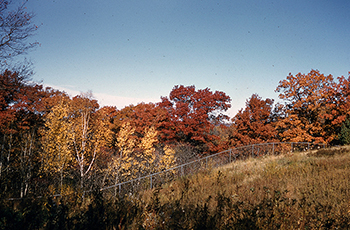

The fern glen: A part of the upland addition was a South-east facing hillside in the far NE corner that descended from the upper ridge line of the new addition. In 1955 the Friends of the Wild Flower Garden received a gift of funds from the Minnetonka Garden Club and the Little Minnetonka Garden Flower Club to create a fern hill in that as yet undeveloped part of the Garden. Martha began this project in 1956 by setting out 2,160 fern plants followed by 308 the next year and ending her part of the project in 1958 when the total reached 2,843 fern plants. Ken Avery would complete it in 1960-61 pushing the fern count to 3,094.
Below: The upland in 1961. The loop path toward the upper right approaching where the new Fern Glen was being developed in the NE corner would be removed in future years. A new path through the Glen was made and is barely visible in the photo. The Odell memorial bench of 1959 is in place but still no visible path to the lone oak. The Nordquist fountain will not show up until 1995. The little triangular area with branching side path noted in photo would also be removed in future years as would the long path paralleling the fence line. Photo courtesy University of Minnesota.
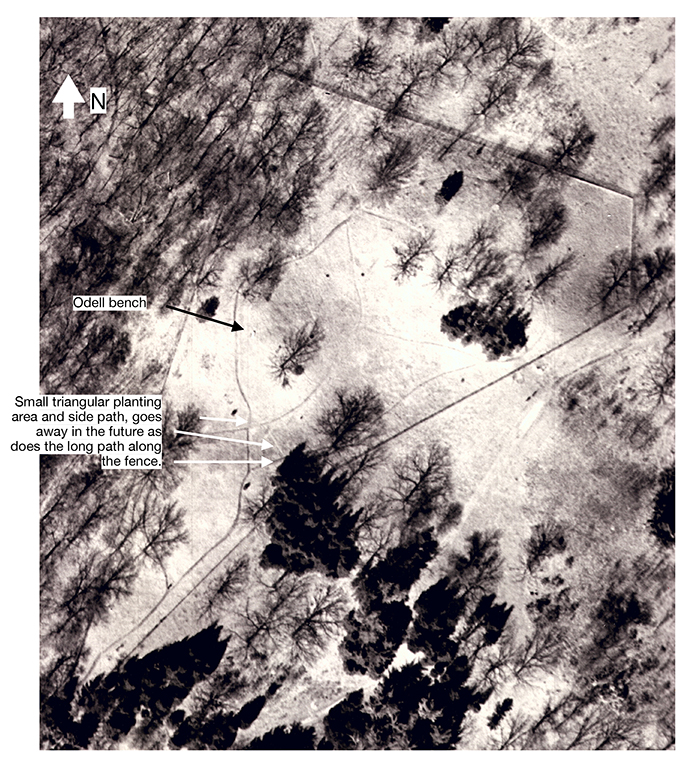
1993
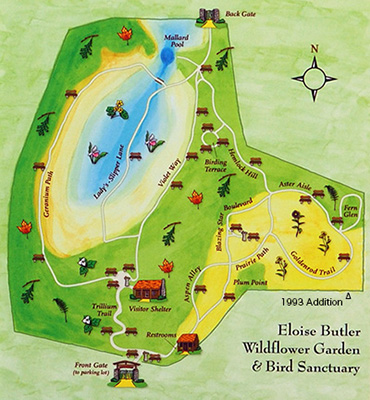
1993 Addition: Following the addition of the upland acreage, it was the curator's work to maintain and develop the land following the principles espoused by Eloise Butler. In 1993 however, Friends member Elaine Christenson would propose a small further addition. Looking at some of Martha Crones old slides she noticed a prairie area east of the current boundary fence. That area was now overgrown, but it once was grassland. Working with Gardener Cary George they both got the idea of adding an extra acre. The cost of adding the needed fencing was met by making use of some old un-needed fencing that still separated the upland from original woodland. The fence work was done by Able Fence Co. hired by the Friends for a net cost of $3,695. (10) This addition brought the Garden up to its current size of 15 acres. You can read Elaine Christenson's account of the addition here: (Article).
Below left: Gardener Cary George and Elaine Christenson. Right: Looking east from the center of the Upland Garden toward the new addition. Photo G D Bebeau.
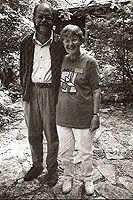
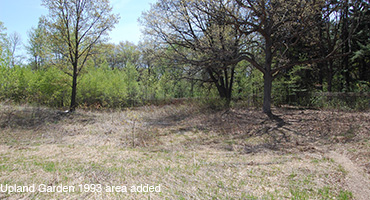
Below: The Upland Garden on October 24, 1955 from a Kodachrome by Martha Crone. (9)
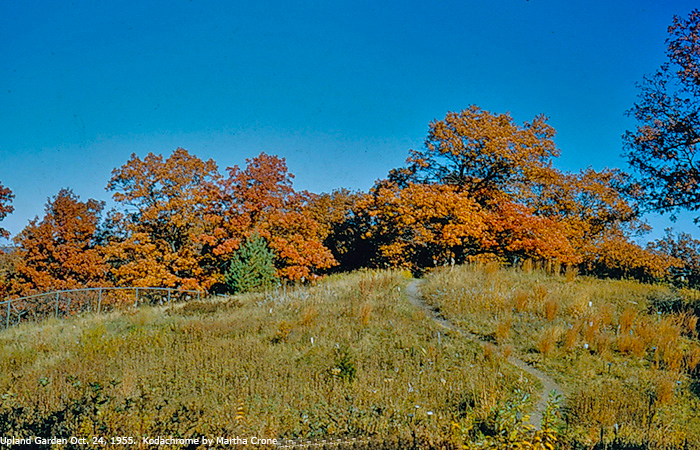
2022
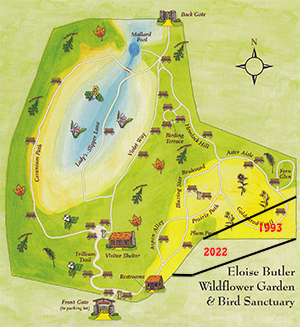
During the winter of 2022/2023 the MPRB removed a section of the old cyclone boundary fence on the east side of the upland and installed a new eight foot high fence further eastward that incorporates into the Garden’s protected area an area of mature upland trees.
This additional was feasible after the Friends Invasive Plant Action Group (FIPAG) cleared the area of invasives over the last four years. When you enter the upland from the main gate you will no longer see the fence with the barbed wire on top that followed the path into the upland.
Map outlining the approximate position of the new 2022 addition and fence position.
The photo below shows where the new fence connects to the remaining older fence section and some of wire caged new shrubs that were planted near it by FIPAG.
